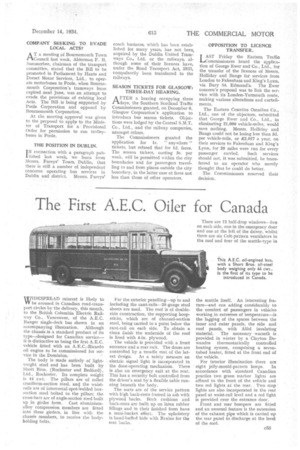The First A.E.C. Oiler for Canada
Page 107

If you've noticed an error in this article please click here to report it so we can fix it.
W/IDESPREAD interest is likely to 11' be aroused in Canadian road-transport circles by the delivery, this month, • to the British Columbia Electric Railway Co., Vancouver, of the A.E.C. Ranger single-deck bus shown in an accompanying illustration. Although the chassis is a standard product of its • type—designed for Canadian service— it is distinctive as being the first A.E.C. vehicle fitted with an A.E.C.-Ricardo oil engine to be commissioned for service in the .Dominion.'
The The body is made entirely of lightweight steel and has been built by Short Bros. (Rochester and Bedford), Ltd., Rochester. Its complete weight is 44 cwt. The pillars are of rolled cruciform-section steel, an the waistrails are of intercostal spot-welded boxsection steel bolted to the pillars; the cross-bars are of angle-section steel built up in girder form. Cast aluminiumalloy compression members are fitted into these girders, in line with the chassis members, to receive the bodyholding bolts, For the exterior panelling—up 'to and including the cant-rails-20-gauge steel sheets are used. The roof is of doubleskin construction, the supporting hoopsticks, which are of channel-section steel, being carried to a point below the cant-rail on each side, To obtain a clean finish the underside of the roof is lined with 4-in. plywood.
. The vehicle is provided with a front entrance and a rear exit. The doors are controlled by a treadle mat of the latest design. As a safety measure an electric signal light is incorporated in the door-operating mechanism. There is also an emergency exit at the rear. This has a security bolt controlled from the driver's seat by a flexible cable running beneath the body.
The seats are of the service pattern with high back-rests framed in ash with plywood backs. Both cushions and back-rests are built up on latex rubber fillings and in their finished form have a semi-bucket effect. The upholstery is hand-buffed hide with Rexine for the seat backs.
the scuttle itself. An interesting fea ture and one adding considerably to the comfort of passengers in vehicles working in extremes of temperature—is the lagging of the spaces between the inner and outer panels, the side and roof panels, with Alfol insulating material. The necessary warmth is provided in winter by a Clayton Dewandre thermostatically controlled heating system, comprising a seventubed heater, fitted at the front end of the vehicle.
For interior illumination there are eight jelly-mould-pattern lamps. In accordance with standard Canadian practice two green marker lights are affixed to the front of the vehicle and two red lights at the rear. Two stop lights are also incorporated in the rear panel at waist-rail level and a red light is provided over the entrance door. Front and rear bumpers are fitted and an unusual feature is the extension of the exhaust pipe which is carried up the rear panel to discharge at the level of the roof.




































































































































































